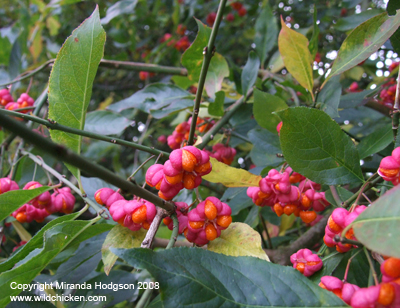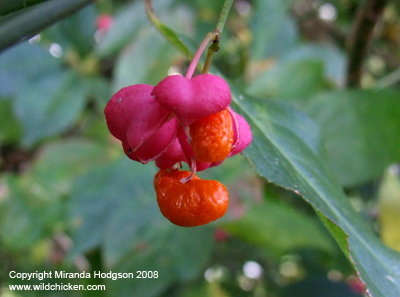


Euonymus europaeus (also called Spindle tree)
Euonymus
europaeus
Hardy, deciduous, native, upright shrub grown for its autumn colour and brightly coloured seeds and seed capsules in autumn. It is unusual in having bright orange seeds with shocking-pink seed capsules; this just isn't something you expect to find growing wild in the UK and a shrub in full fruit is an amazing sight the first time you see one. You can't help wondering, 'Where did that come from?' and it's quite a surprise to discover that it is a native plant, not from somewhere exotic.
The name Spindle tree comes from the fact that the stems were once used for making weaving spindles and knitting needles.
Euonymus europaeus is a good addition to hedges or can be used as part of a mixed border. The bright foliage is very noticeable in roadside hedgerows during autumn.
The flowers attract beneficial insects in spring and the fleshy seed coating is much sought after by birds, particularly robins. The plant has been called 'Robins' bread' and it is said that robins will fiercely defend a Euonymus tree. The fruits are, however, poisonous to humans; birds only digest the fleshy outer layer of the seed and the seed itself passes through birds unchanged.
Green foliage in spring and summer, which turns bright pink-red in autumn. Bright orange and pink seeds in autumn.
Habit - upright, bushy. H: 3m S: 2.5m
Stem - smooth, round, straight, dark green.
Leaves - simple, opposite, lanceolate, mid-green, very lightly serrated.
Flowers - produced in early summer, four-petalled and fairly inconspicuous in shades of greenish-white.
Fruits/seeds - bright pink capsules, made up of four valve pods, each containing an bright orange seed. The seeds ripen in autumn.
Sun to shade.
Any well-drained soil.
Hardy.
Cut back in spring to maintain size or shape and apply a mulch of garden compost or well rotted manure to the base of the plant at the same time.
Euonymus europaeus is a winter host for black aphids, so growing broad beans near to this plant may cause problems. Saying that, aphids are a good food source for many small birds so if you aren't growing broad beans you can have a beautiful shrub and give the birds a good meal at the same time.
Sow ripe seed in autumn in a cold frame - the seed needs a period of cold in order to germinate. Summer cuttings of semi-ripe wood can also be taken in summer, or ripe wood cuttings can be taken in late autumn.
Garden Plant Information list of plant care info by botanical name